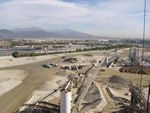By Bill Campbell
We all know that dust control is a challenging problem for onsite management of aggregate facilities. The time and expense required to maintain an environmentally friendly work area can get costly, and the threat of expensive citations can be troublesome. A comprehensive chemical treatment program, used properly, can minimize dust for extended periods of time and reduce your costs for maintenance.
Dust control is typically required in three main areas:
- Roads.
- Static piles and slopes.
- Transfer points.
When road dust is a problem, the recommended solution is magnesium chloride. This product attracts moisture and actually pulls it out of the atmosphere, keeping the roads in a constantly damp state, holding down dust and absorbing new dust deposits.
Magnesium chloride also stabilizes the surface and allows the road to compact, which can result in less potholes, significantly reducing road maintenance and minimizing dirt trackout.
Typically, one spray application of magnesium chloride is enough to manage road dust all year long. The reduction in water truck trips creates a significant cost savings, resulting in lower fuel costs, reduced labor costs, and less wear and tear on your vehicles.
Stationary Piles
For stationary piles of aggregate that do not see traffic but are prone to wind dust, the recommended treatment is liquid latex. The latex solution creates a thin, skin-like coating over the area, eliminating the need for frequent water soakings.
For example, you may have a gravel pile or pit slope that seldom incurs any physical interference from plant equipment; however, when the wind blows, it creates a dust storm that pollutes neighborhood yards and swimming pools. A cost-effective solution of latex can protect slopes and the surrounding area for up to a year or more.
The proper dilution rate of the latex solution will change depending on the desired time period needed to protect the areas. For stockpiles that are rarely disturbed, a latex solution can be created to last a few days to several months. The treatment plan should be planned to meet the needs of your specific application, depending how often the area is likely to be disturbed.
When dust is created from material transfer points, such as from conveyor to shaker screen, screen to crusher, or crusher to conveyor, dust is commonly exhausted into the air. Here, a foaming agent applied directly to the aggregate, using a quality foaming chamber, is effective in combating the dust control problem. This foaming treatment stays with the material throughout the process to reduce the likelihood of dust reappearing down the line.
For other areas that do not require a specific chemical treatment but still require attention from a water truck, a good surfactant or “wetter water” agent should be used for optimum results. A surfactant breaks down the surface tension of the water, allowing the water to penetrate and adhere to the surface more efficiently. Consequently, the treatment will evaporate much slower and work longer.
Here again, water truck trips can be reduced – typically by 60 to 70 percent, resulting in less wear and tear on the vehicle and lower fuel costs. Water can be spared, diesel use can be cut, and man-hours can be reduced. Wetting agents can also be used in conjunction with the magnesium chloride and liquid latex solutions to improve penetration and effectiveness.
Cost Savings
The true cost savings in reduced labor, diesel, water, and wear and tear on equipment typically offsets the cost of chemicals used. The real payback, however, can be realized in the form of zero citations and shutdowns due to dust escapes and trackout onto city streets.
Locations that adopt the regular use of these chemical solutions to correct fugitive dust problems will benefit from a better working environment, improved efficiencies and cost savings. More importantly, if these procedures are documented as part of a plant’s working environmental improvement policy, it helps to create a good standing with federal and state regulatory agencies as well as the surrounding neighborhood.
Bill Campbell is an aggregate industry specialist for Applied Industrial Technologies, Cleveland.

